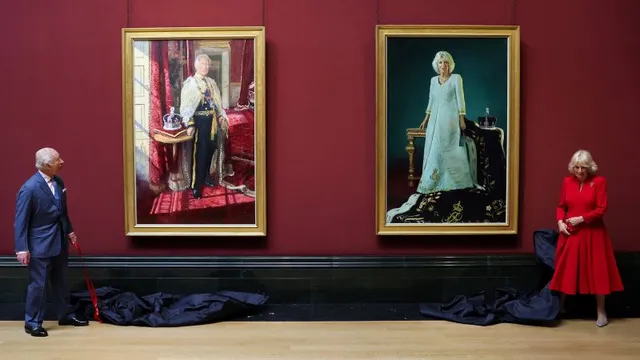
King and Queen unveil stunning coronation portraits at National Gallery
2025-05-07 00:00- The unveiling of the portraits at the National Gallery took place on May 6, 2025.
- The King and Queen's portraits will be displayed for a month before moving to Buckingham Palace.
- Both the King and Queen appreciated their likenesses, signifying a positive response.
Express your sentiment!
Insights
On May 6, 2025, King Charles III and Queen Camilla unveiled their official state portraits at the National Gallery located in London, marking the second anniversary of their coronation. The paintings, featuring both royal figures in ceremonial attire, depict the King in a naval uniform complemented by the Robe of State and the Imperial State Crown and the Queen adorned in her coronation dress along with her crown and Robe of Estate. The artist responsible for King Charles' portrait, Peter Kuhfeld, noted that the creation took over a year and a half, with five sittings involving the King, who actively contributed to the process, reflecting both regal and human qualities in the artwork. Similarly, Queen Camilla's portrait was crafted by Paul S. Benney, who spent nearly a year at Clarence House to produce an intimate representation of the Queen, highlighting the crown known as Queen Mary's Crown as the focal point. Both artists emphasized the importance of creating portraits that balance the grandeur of royal imagery with the personal character of their subjects. Following the unveiling, the portraits will be displayed at the National Gallery for one month before moving to their permanent location at Buckingham Palace's Throne Room. The unveiling of these portraits comes almost a year after a prior, albeit divisive, portrait of King Charles was revealed, which sparked a variety of reactions from the public due to its modern aesthetics and bold color scheme.
Contexts
The history of royal portraits in the UK is a rich tapestry that reflects not only the evolving styles of art but also the societal changes and royal narratives that have shaped the country. From the medieval period onward, royal portraits served as a crucial means of communication, projecting power, legitimacy, and the divine right of kings. Early portraits were often symbols of authority, painted in a formal style to convey the grandeur and importance of the royals. Artists like Hans Holbein the Younger made significant contributions during the Tudor period, capturing the likenesses of Henry VIII and his court in a way that emphasized their stature and command. These early works were characterized by their attention to detail and the use of symbolism, allowing viewers to understand the values and aspirations of the monarchy during that era. As the centuries progressed, royal portraits evolved in tandem with artistic movements and societal shifts. The Stuart and Georgian periods brought about an increase in the personalization of royal portraits, where monarchs were depicted in more relaxed and informal settings. This change reflected a move toward an ideal of accessibility and modernity in the royal image. Notable artists like Sir Joshua Reynolds and Thomas Gainsborough emerged during this time, employing new techniques such as light and color to create portraits that not only highlighted royal features but also captured the personality and character of their subjects. These artworks became vital in the cultivation of public personas, effectively engaging with the evolving sentiments of the populace. The Victorian era marked another significant transformation in the representation of the monarchy through portraiture. With the ascension of Queen Victoria, royal portraits took on new dimensions, as the public's fascination with the royal family grew. Queen Victoria herself was a pioneering figure in the use of photography, as her reign saw the advent of this technology allowing for more intimate and candid images of the royal family. Photographs supplemented traditional painted portraits and helped to create a more relatable image of the monarchy. This dual representation was instrumental in shaping public perception and identity around the royal family, emphasizing both their roles as sovereigns and as individuals within a family unit. In contemporary times, the tradition of royal portraiture continues to be a significant aspect of royal representation in the UK. Artists are now embracing varied styles and media to depict members of the royal family, often incorporating modern themes and cultural reflections. Noteworthy examples include the portraits of Prince William and Catherine, the Duchess of Cambridge, which differ significantly from earlier depictions by embracing contemporary artistic practices. Modern royal portraits not only commemorate significant milestones and events but also aim to resonate with a diverse and multicultural society, ensuring that the monarchy remains a relevant and integral part of British life in the 21st century. Overall, the evolution of royal portraits in the UK underscores a narrative of continuity and change, mirroring the dynamic history of the monarchy itself.